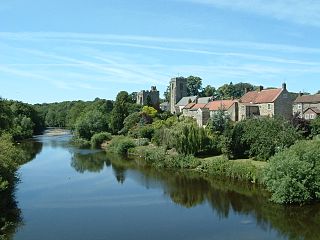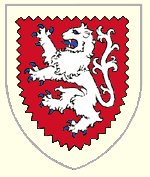Richard FitzRoy was the illegitimate son of King John of England and was feudal baron of Chilham, in Kent. His mother was Adela, his father's first cousin and a daughter of Hamelin de Warenne by his wife Isabel de Warenne, 4th Countess of Surrey.

Scrivelsby is a village and ecclesiastical parish in the East Lindsey district of the County of Lincolnshire, England. It is situated 2 miles (3.2 km) south of Horncastle and is on the B1183 road 1 mile (1.6 km) east from the A153 road. It is administered by the civil parish of Mareham on the Hill.
The feudal holder of the Manor of Scrivelsby in Lincolnshire, England, has, since the Norman Conquest in 1066, held the manor from the Crown by grand serjeanty of being The Honourable The King's/Queen's Champion. Such person is also the Standard Bearer of England. The current Queen's Champion is a member of the Dymoke family, which has included many Champions.

West Tanfield is a village and civil parish in the Hambleton district of North Yorkshire, England. The village is situated approximately six miles north of Ripon on the A6108, which goes from Ripon to Masham and Wensleydale. The parish includes the hamlets of Nosterfield, Thornborough and Binsoe.

Baron FitzHugh, of Ravensworth in North Yorkshire, is an abeyant title in the Peerage of England. It was created in 1321 for Sir Henry FitzHugh. The title passed through the male line until the death in 1513 of George FitzHugh, 7th Baron FitzHugh, when it became abeyant between his great-aunts Alice, Lady Fiennes and Elizabeth, Lady Parr, and to their descendants living today, listed below. The family seat was Ravensworth Castle in North Yorkshire, situated 4.5 miles north-west of Richmond Castle, caput of the Honour of Richmond, one of the most important fiefdoms in Norman England.

John de Grey, 1st Baron Grey de Rotherfield, KG was an English soldier and courtier. John was the son and heir of Sir John de Grey of Rotherfield, by Margaret, daughter of William de Odingsells.

Gerald FitzMaurice, jure uxoris 1st Lord of Offaly was a Cambro-Norman nobleman who took part with his father, Maurice FitzGerald, Lord of Llanstephan, in the Norman Invasion of Ireland (1169–71). Together with his five brothers and one sister Nesta they founded the notable FitzGerald/FitzMaurice dynasty which was to play an important role in Irish history.
Robert Marmion, 3rd Baron Marmion of Tamworth was an Anglo-Norman nobleman and itinerant justice. He was reputed to have been the King's Champion but his grandson, Phillip, is the first Marmion to have a solid claim to this. Robert was descended from the lords of Fontenay-le-Marmion in Normandy, who are said to have been hereditary champions of the Dukes of Normandy.
Marmion is a surname found in France, Great Britain and Ireland, of Norman-French origin. The origin of the surname itself is disputed.

Roger Beler was a Baron of the Exchequer and right-hand man of Hugh le Despencer and King Edward II. Beler was killed by the Folville gang in 1326.
Gervais, Count of Rethel was a French archbishop and nobleman. He was the son of Count Hugh I and his wife Melisende of Crécy. He succeeded his father as Count of Rethel.

There have been four different baronies held by the Marmion family, two feudal baronies, one purported barony created by Simon de Montfort and one barony by writ.
Philip Marmion, 5th and last Baron Marmion of Tamworth was King's Champion and Sheriff. He was descended from the lords of Fontenay-le-Marmion in Normandy, who are said to have been hereditary champions of the Dukes of Normandy.

The Aguillon family, of French origin, were feudal landowners in England who held estates in several southern counties from before 1135 to 1312. Surviving records suggest various branches which all ended without male heirs, the lands going to daughters or sisters and their husbands. The family seems to have been initially associated, perhaps as under-tenants and maybe through marriage, with the Marmion family, witnessing charters alongside them in Normandy in 1106 and later occupying their land in England.
William Marmion, Baron Marmion of Torrington, was an English clergyman and member of Simon de Montfort's Parliament.
John Marmion, Baron Marmion of Winteringham was an Anglo-Norman baron who represented Lincolnshire in Parliament and fought in the Wars of Scottish Independence.
Sir John Marmion, Baron Marmion of Winteringham was an Anglo-Norman baron who represented Lincolnshire in Parliament and fought in the Wars of Scottish Independence.
Sir William de Paris was a Member of Parliament for Lincolnshire and soldier of the Wars of Scottish Independence.

Sir Thomas Grey of Heaton Castle in the parish of Cornhill-on-Tweed, Northumberland, was a soldier who served throughout the Wars of Scottish Independence. His experiences were recorded by his son Thomas Grey in his chronicles, and provide a rare picture of the day to day realities of the Wars. His career, blemished by his suicidal charge at the Battle of Bannockburn, a contributing factor to the devastating English defeat, is perhaps best known for his role in the tale of Sir William Marmion the chivalric knight of Norham Castle.
Robert Marmion was an Anglo-Norman baron and soldier who rose to prominence during the wars between King Stephen and the Empress Matilda.









